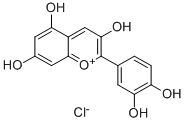All AbMole products are for research use only, cannot be used for human consumption.

Cyanidin chloride is a subclass of anthocyanin, displays antioxidant and anti-carcinogenesis properties, could be used for treatment of diabetes mellitus complications. Cyanidin Chloride (IdB 1027) inhibits receptor activator of NF-κB ligand (RANKL)-induced NF-κB activation, suppresses the degradation of IκB-α and attenuates the phosphorylation of extracellular signal-regulated kinases (ERK). Cyanidin Chloride (IdB 1027) abrogates RANKL-induced calcium oscillations, the activation of nuclear factor of activated T cells calcineurin-dependent 1 (NFATc1), and the expression of c-Fos. Cyanidin Chloride (IdB 1027) protects against OVX-induced bone loss in OVX-induced osteoporosis mouse model.
| Molecular Weight | 322.7 |
| Formula | C15H11ClO6 |
| CAS Number | 528-58-5 |
| Form | Solid |
| Solubility (25°C) | DMSO 20 mg/mL |
| Storage | -20°C, sealed |
| Related Products |
|---|
| Gadoteric acid
Gadoteric acid is a macrocyclic, paramagnetic, gadolinium-based contrast agent that can be used for magnetic resonance imaging (MRI) of the brain, spine, and related tissues. Gadoteric acid is able to detect and visualize areas of blood-brain barrier disruption and abnormal vascular distribution. |
| Sulfo-SANPAH
Sulfo-SANPAH is a primary amine-nitrobenzene azide cross-linker. Sulfo-SANPAH is a heterobifunctional crosslinker that contain an amine-reactive N-hydroxysuccinimide (NHS) ester and a photoactivatable nitrophenyl azide. |
| 2-Deoxy-2-fluoro-D-glucose
2-Deoxy-2-fluoro-D-glucose is a radiolabeled glucose analog, which is commonly used in medical imaging techniques such as positron emission tomography (PET) scans. |
| 2-Bromo-4-chlorophenylacetic acid
2-Bromo-4-chlorophenylacetic acid is a biochemical reagent. |
| CPN-351 TFA
CPN-351 TFA is a selective pentapeptide antagonist of human NMUR1 with a pA2 of 7.35. CPN-351 TFA can be used for the research of inflammation. |
All AbMole products are for research use only, cannot be used for human consumption or veterinary use. We do not provide products or services to individuals. Please comply with the intended use and do not use AbMole products for any other purpose.


Products are for research use only. Not for human use. We do not sell to patients.
© Copyright 2010-2024 AbMole BioScience. All Rights Reserved.
